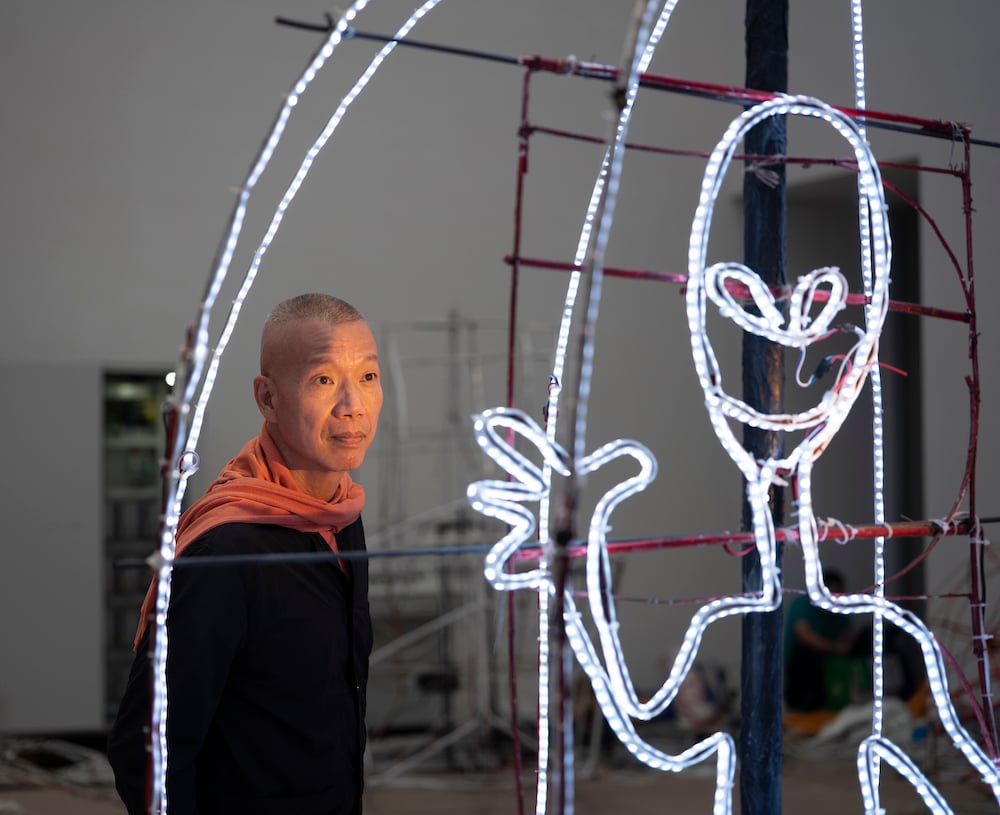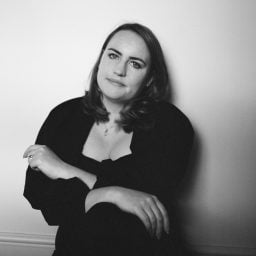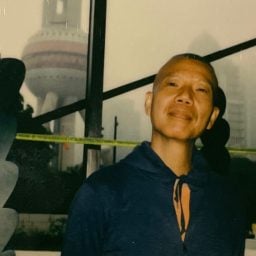Cai Guo-Qiang is no stranger to spectacle.
The Chinese artist, who is known for his explosive fireworks displays and daring experiments with gunpowder, served as the director of visual and special effects for the opening and closing ceremonies of the Beijing Olympics in 2008. His work across drawing, installation, video, and performance has been variously honored with the Golden Lion at the 1999 Venice Biennale, to the U.S. National Medal of Arts.
For his latest act, Cai has opened a major exhibition to inaugurate the Museum of Art Pudong (M.A.P.) in Shanghai. Titled “Odyssey and Homecoming,” the exhibition spans three floors of the Jean Nouvel-designed museum, and includes 119 of his signature gunpowder paintings, as well as an overview of his long-running dialogue with Western art history.
The artist, who has been based in New York since 1995, is also marking his homecoming to Shanghai, where he studied stage design in the 1980s, by debuting his first-ever VR work and a new kinetic light installation about extraterrestrial life.
We caught up with Cai about his homecoming and his interest in cosmology.
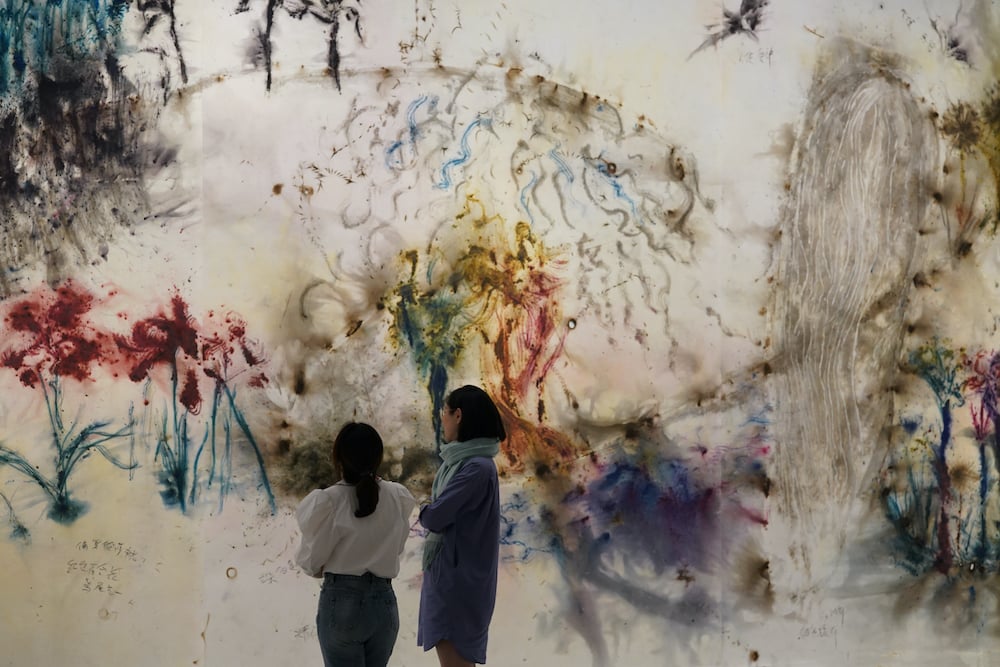
Cai Gui-Qiang, Color Gunpowder Drawing for City of Flowers in the Sky. Exhibition view at the Museum of Art Pudong, 2021. Photo by Mengjia Zhao, courtesy Cai Studio.
Your exhibition “Odyssey and Homecoming” opened this month at the Museum of Art Pudong in Shanghai. Can you tell me about your relationship with the city?
Shanghai was my first port of departure. I savored the paints of the Shanghai art supplies factory in the early ‘70s. I left my hometown for the first time in 1978 and stole a ride on the coal train to Shanghai to see a French 19th-century rural Landscape painting exhibition, which was also the first time I saw originals by foreign painters in person. I have a strong memory of this exhibition. It opened the door to drastically different artistic styles for me, which was deeply affecting.
In the early ‘80s, I left Quanzhou to study at the Shanghai Theatre Academy. At one point, I felt pity that I was studying stage design rather than studying fine arts the Academy of Fine Arts. I was actually very lucky because at that time, the Academy of Fine Arts was quite conservative. It focused on traditional sketching and plastic-art training, and maintained that artistic training should serve bigger political purposes. On the contrary, the Theatre Academy was more experimental.
Can you tell us about any mentors you had there who influenced the way you think?
Zhou Benyi, my teacher in the department of stage design, had a great impact on me. He was the only one in Shanghai who had studied oil painting at the Ilya Repin Leningrad Institute. Aside from his solid painting skills, he emphasized the importance of concepts and forms after a trip to the U.S., where he had been invited by the U.S. Information Agency shortly after Chinese economic reform. In a sense, we were his “lab rats” for educational reform, as he was exploring the path while teaching us. Under his guidance, we turned to contemplating how and why we create. It enlightened me. Using Shakespeare’s plays as metaphor, the scripted story is always there, but the key is how you interpret it, what you want to say about it, and how to enact it.
My training at the Theatre Academy also led me to focus on the fluidity of time, multimedia materials, and spatial construction, as well as the spirit of collaborative work. As a result, this experience unintentionally laid a solid foundation for my career as a contemporary artist. Mr. Zhou was always strict with me, and never gave me an easy pass on my proposals. Sometimes he had me redo them five or six times. Later he told me it was because he wanted to see what other surprises and ideas I could offer and what other tricks I could do.
This pursuit of novelty and innovation motivated me to secretly experiment with gunpowder as an artistic medium while I was still a college student. Shanghai was practically the embodiment of Western culture for me—the Bund, the sycamore trees, the Bai Du Bridge, and especially those iconic churches, which are also the subjects of some of my early paintings.
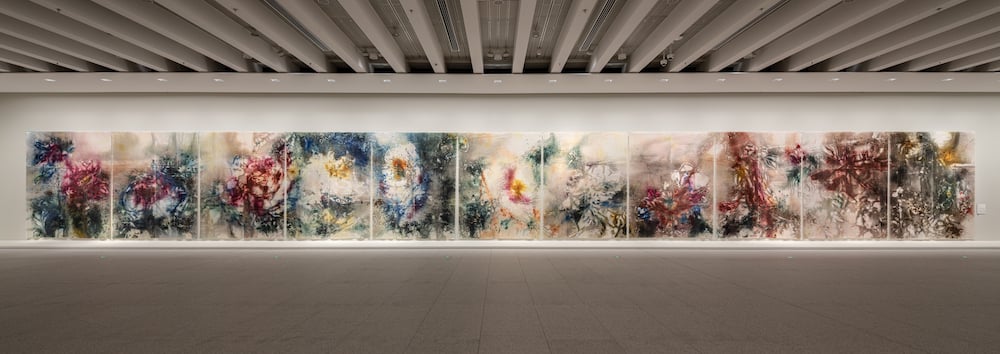
Cai Guo-Qiang, Transience II (Peony). Exhibition view at the Museum of Art Pudong, 2021. Photo by Gu Kenryou, courtesy Cai Studio.
The exhibition includes 119 of your gunpowder paintings. How has the way you think about these works changed since you first began making them decades ago?
Gunpowder has a life of its own. The question has always been: how can I fully present its vitality and the charisma of its spirit? The uncontrollability does not just lie in the material itself—gunpowder brings out the uncontrollable side in me! If I don’t lose control, neither will gunpowder.
As I gain experience manipulating gunpowder, the need for losing control grows stronger. With more experience and better understanding of the material, the fireworks themselves becomes more controllable. Ultimately the gunpowder is there to explode and unleash me, not only to explode the painting surface.
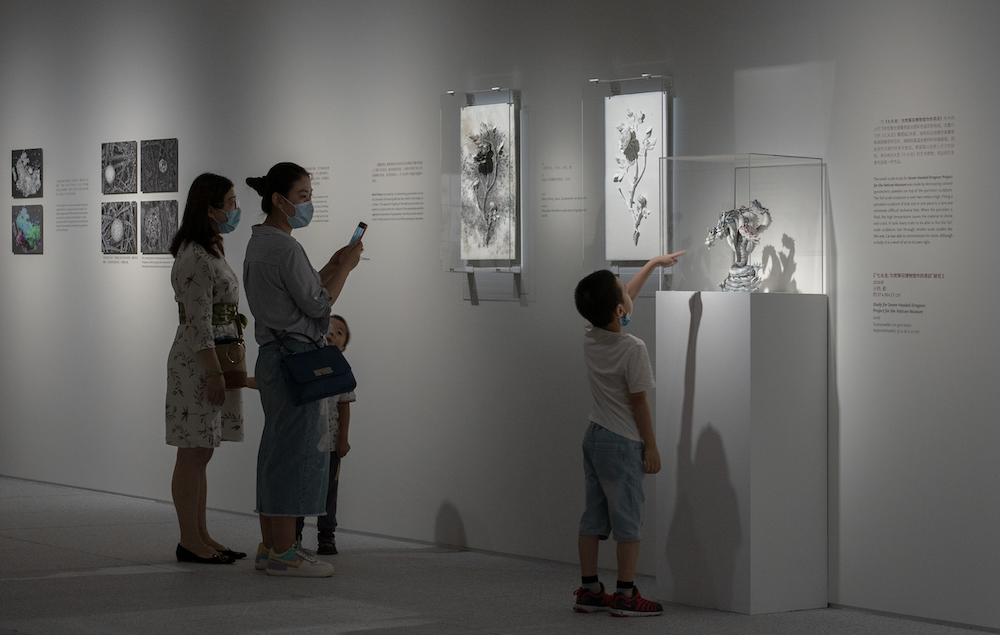
Exhibition view of A Material Odyssey, a Getty Conservation Institute research exhibition at the Museum of Art Pudong, 2021. Photo by Gu Kenryou, courtesy Cai Studio.
As part of the exhibition, you have recreated your Individual’s Journey Through Western Art History for a Chinese audience. What is different about this audience, and how did you adapt the work?
I first had the idea of embarking on a journey through Western art history when I was young. Throughout the journey, I let the spirit and creativity of the master artists cultivate my own qi, and in doing so, I tried to confront the difficulties in contemporary painting. I think dialoguing with different chapters of Western art is to pay respect to, and at the same time decentralize the West. When this exhibition tours to China, I believe it in a sense challenges the Sino-centric view, and pursues a kind of liberty and equality, because it advocates for the idea of inheriting all civilizations in mankind’s history as our united heritage.
This exhibition was first held at the Palace Museum last December at the four major galleries of the Meridian Gate. These are works I created along my “odyssey,” for exhibitions at several museums in the West. Some of these museums used to be palaces or were closely associated with the court culture. When the works made in the context of Western palaces are installed at the Palace Museum, a sense of tension created by the dialogue and contrast between different cultures became apparent.
The Museum of Art Pudong, a venue created for Modern and contemporary art, is quite a different context for the exhibition. Compared to the Palace Museum, M.A.P. is more suitable for displaying artworks. It has extensive white floors and walls as well as Malevich’s “Suprematist” ceiling. When looking at the art, one tends to think about the artist’s aesthetic consideration, the methodology behind it, and the choice of materials. Of course, in this “white cube,” my exhibition, as well as the Tate and the Miró exhibitions are perhaps quite pristine and elitist. Conversely, the new work Encounter with the Unknown created for the X Hall is quite experimental and adventurous.
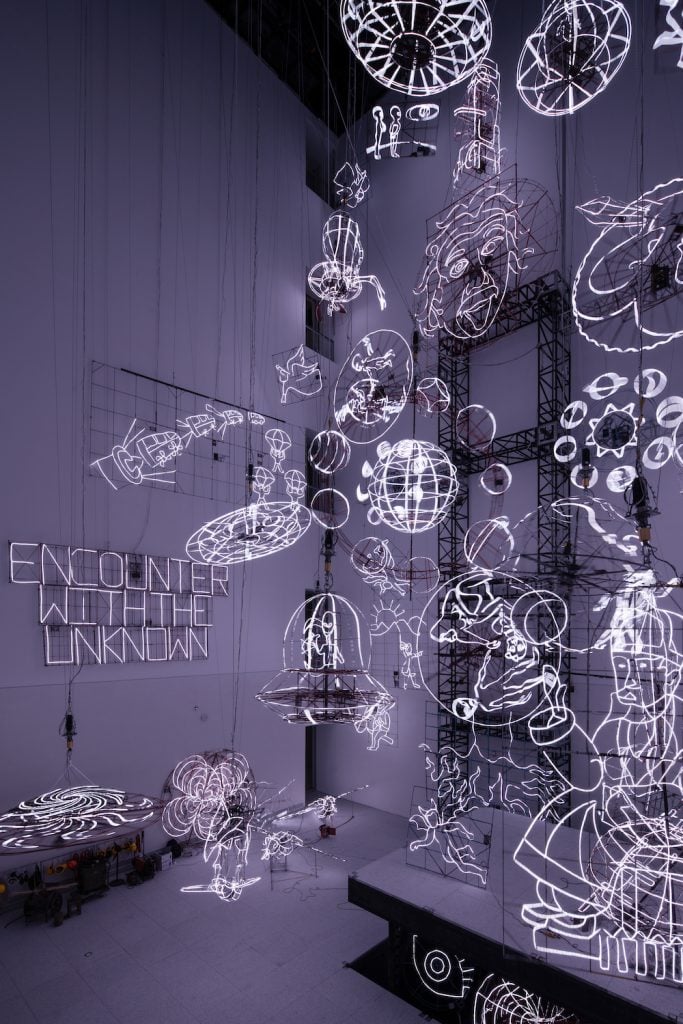
Exhibition view of Encounter with the Unknown at the Museum of Art Pudong, 2021. Photo by Gu Kenryou, courtesy Cai Studio.
Let’s talk about that newly commissioned installation, Encounter with the Unknown, which draws on images from different stories and myths of humans embracing the cosmos, from Mayan cosmology to America’s obsession with the little green men. What prompted your fascination with the extra-terrestrial?
As a child, I frequently gazed up at the stars and imagined what lies beyond the starry sky. Moving to Japan in 1986, I soon moved beyond the East-West dichotomy, and observed humankind from the perspective of the cosmos. In 1989, I initiated the series of explosion events Projects for Extraterrestrials. Back then I already believed that there existed extraterrestrials and superpower, and that there is the unseen world behind our world. So I very much hoped these elements could be incorporated in my art, and that my artistic methodology and philosophy would have a spiritual dimension.
My installation Encounter with the Unknown continues the cosmic theme, through which I wish to convey a boy’s curiosity and sentiments toward the unknown world.
The work weaves together humanity’s desire to defy gravity and embrace the cosmos shared across civilizations. For example, at the very beginning, mankind did not believe that the earth is round. Seeing the sails on the sailboat sink afar, they thought they could blow the sailboat that is large enough off to the sky. Throughout history, some wanted to fly into the sky on birds, and then there was Wanhu, who tied rockets under his chair in an attempt to send himself off into the universe.

Still for VR work Sleepwalking in the Forbidden City Courtesy Cai Studio.
You are also using the occasion of the exhibition to debut your first-ever VR work: Sleepwalking in the Forbidden City, in which people can watch one of your daytime firework shows over the historic landmark. How did you find working with the medium was able to open up your artistic practice?
I have just begun to experiment with VR. The new technology and its worldview make it possible to create new ways to represent our world and its long history. For example, VR’s characteristics of manifesting the surreal and unseen should be amplified in my art, since my art is about using the visible to represent the unseen.
What also concerns me is how to imbue this high-tech medium with warmth as well as an animalistic energy. That’s why I insisted on making the VR film in the style of my Peasant da Vincis, instead of invoking the kind of virtual, CG aesthetics seen in Hollywood movies.
I grafted different languages and mediums together, not minding it being raw and contradictory. The conceptual quality born from the collaging and conflicting of different languages, is more important to me as an artist.
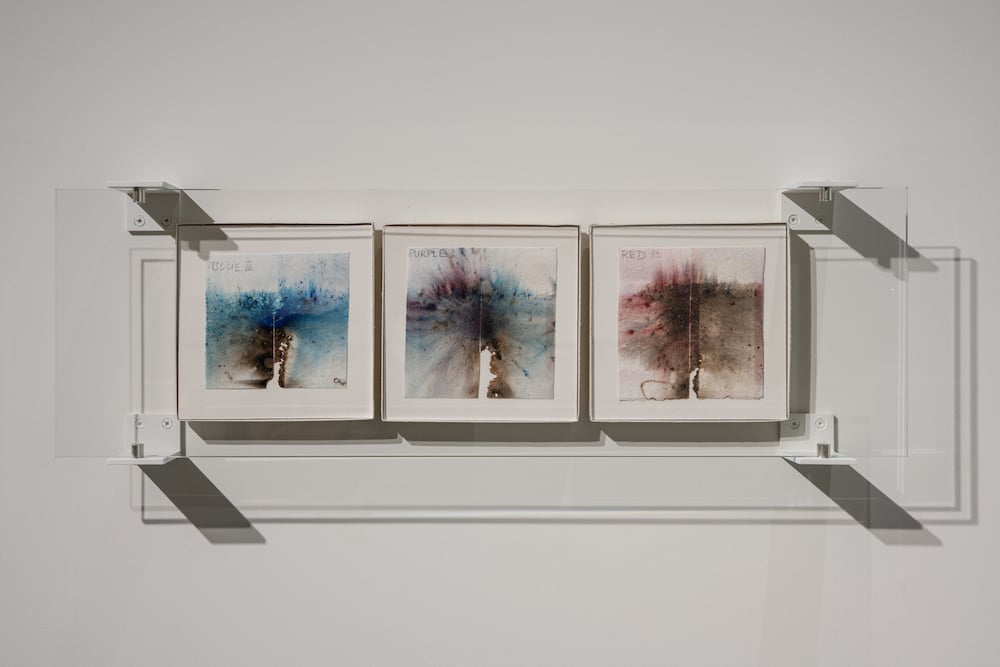
Exhibition view of A Material Odyssey, a Getty Conservation Institute research exhibition at the Museum of Art Pudong, 2021. Photo by Gu Kenryou, courtesy Cai Studio.
Another new technology has been making waves in the art world this past year: NFTs. You have delved into the field with your “Transient Eternity—101 Ignitions of Gunpowder Paintings” which recently sold for $2.5 million. What do you think about NFTs, and do you see yourself experimenting with them further?
These 101 ignition moments from the pieces I created during my Individual’s Journey Through Western Art History always exist as an integral part of the gunpowder paintings. NFT technology makes it possible to own and collect these moments, which are transformed as “transient eternity.”
The project asks what defines an artist’s work and what is an art project. It reflects on the questions surrounding the transience and eternity of the digital age embodied by NFTs, and the core concept of how value is stored. In the age of pandemic and post-pandemic, through this project, I also reflect on the weight of transient existence in the eternal river of time.
I already have a number of ideas for NFTs. I think my next NFT projects ought to be more adventurous than what have been achieved so far. Is it possible to create an art project with a more forward-looking vision, and with more compelling forms and concepts, by leveraging the core values unique to NFT technology?
“Cai Guo-Qiang: Odyssey and Homecoming is on view through March 7, 2022, at the Museum of Art Pudong, Shanghai.
